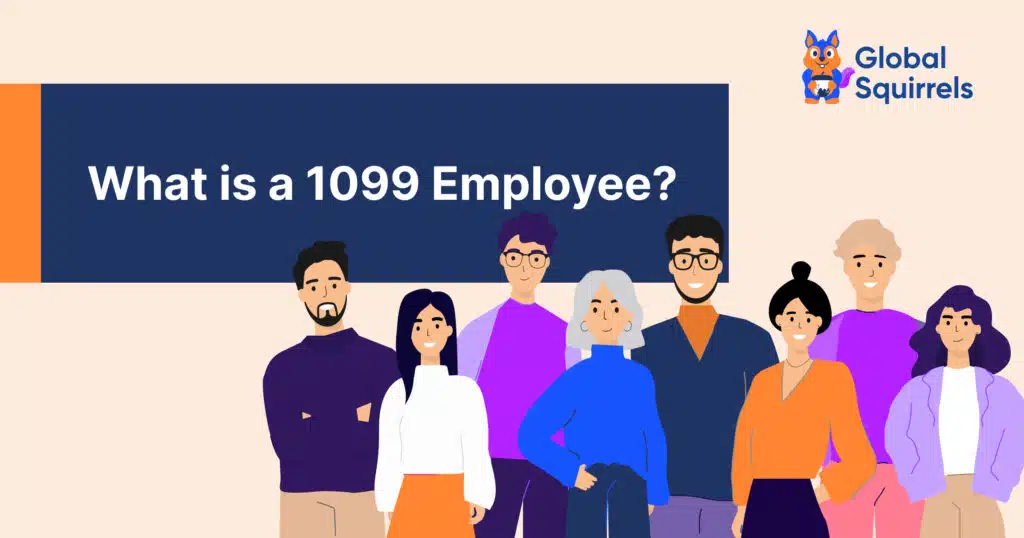What is a 1099 Employee?

In today’s interconnected world, businesses transcend borders, tapping into global markets and opportunities that were once beyond reach. They reach out across continents, collaborate with diverse cultures, and tap into international markets with ease. This expansion has given birth to a global workforce, a collective of talents from different corners of the world, each bringing their unique skills and experiences to the table. As enticing as this sounds, it comes with its own set of challenges, primarily related to understanding and managing various employee classifications. Amidst these classifications, there’s one term that often surfaces, especially in the American business context: the “1099 employee.” So, what is a 1099 employee? Despite the term, a 1099 employee isn’t technically an employee in the traditional sense. Instead, it refers to independent contractors in the U.S. who receive their income reported on the Form 1099-MISC.
For businesses expanding their horizons globally, understanding this classification becomes pivotal. Whether you’re planning to onboard international talent or trying to streamline your current workforce, having clarity on what “1099 employee means” can play a significant role in ensuring compliance and optimizing work dynamics.
Basic definition: What is a 1099 employee?
When diving into the complexities of employment classifications, it’s crucial to start with a clear understanding. So, what is a 1099 employee? The term can be slightly misleading, as a 1099 employee is not an employee in the conventional sense we often think of. Instead, they are more accurately described as independent contractors. These are professionals who offer their services on a contractual basis without being tied down as a traditional, permanent employee.
Now, why the term “1099”? The designation originates from the IRS Form 1099-MISC, a specific tax form used in the United States. This form is instrumental in reporting income earned by individuals through self-employment. In essence, when someone refers to a “1099 employee,” it means that the individual is an independent contractor whose earnings are reported through the 1099 form, rather than the W-2 form that is used for regular employees.
But it’s not just about taxation. Labeling someone as a 1099 independent contractor versus a W-2 employee brings along a host of differences in the way they’re managed, the benefits they receive, and their overall role within an organization. In the realm of global employment, it’s of paramount importance for companies to distinguish between these classifications, ensuring all interactions and agreements align with legal and operational standards.
Difference between W-2 and 1099 workers
Navigating the global employment landscape requires businesses to be well-acquainted with various employment classifications. Two such designations that often lead to confusion, especially in the U.S., are the W-2 and 1099 workers. While both refer to people earning income, the manner in which they operate, receive benefits, and pay taxes is distinct. Let’s demystify these differences.
W-2 workers
A W-2 worker refers to a traditional employee. These individuals receive the IRS Form W-2 from their employers, which reports their annual wages and the amount of taxes withheld from their paychecks. Here are some features of W-2 workers:
Tax withholdings
One of the main responsibilities for employers with W-2 employees is withholding federal, state, and other taxes from the employee’s paycheck. This means that the employer actively contributes to Social Security, Medicare, and unemployment taxes on behalf of the employee.
Benefits
W-2 employees often enjoy benefits such as health insurance, paid leave, retirement plan contributions, and more. These benefits are typically a part of the employment contract and can significantly influence a person’s decision to accept a job offer.
Job security
These workers usually have more job security compared to their 1099 counterparts. They are often protected by labor laws, which could include minimum wage regulations, overtime pay, and protection against unlawful termination.
1099 workers
When someone asks, “What is a 1099 employee?”, they’re often referring to independent contractors. Unlike W-2 workers, these professionals aren’t bound by a traditional employment relationship. Here’s what defines a 1099 worker:
No tax withholdings
For a 1099 independent contractor, employers don’t withhold taxes. Instead, these contractors are responsible for paying their own federal and state taxes, including both the employee and employer portions of Social Security and Medicare taxes.
Benefits
Typically, independent contractors don’t receive the benefits that W-2 employees enjoy. This means no health insurance, retirement contributions, or paid leaves from the employer. However, this gives them the flexibility to negotiate their rates and terms.
Flexibility
One of the most significant advantages for many 1099 workers is flexibility. They often have the autonomy to decide their work hours, choose their projects, and sometimes even set their pay rates. This flexibility can be a double-edged sword, as it also means less job security than W-2 employees.
Related read: Difference Between Independent Contractors and Employees
Advantages of hiring 1099 workers for global businesses
In the multifaceted realm of global business, employing the right talent while optimizing costs and flexibility can be the differentiating factor between success and stagnation. With the advent of the digital age and the increasing ease of international collaboration, 1099 workers have emerged as a viable option for many businesses looking to expand their horizons. So, what advantages does hiring a 1099 independent contractor bring to global enterprises? Let’s delve into the details.
Flexibility
Project-specific talent
One of the primary benefits of hiring 1099 workers is the flexibility it offers. Companies can easily onboard specialists tailored to the needs of specific projects. This means, instead of having a permanent employee whose skills might not be in demand throughout the year, businesses can hire relevant talent just for the duration of the project.
Adaptable workforce
Global markets are dynamic. The demand in one region or sector can shift rapidly. With 1099 workers, companies can swiftly scale up or down, adapting to market conditions without the lengthy processes associated with traditional employment.
Cost efficiency
No traditional benefits
While the topic of benefits might seem like a disadvantage at first glance, from a business perspective, not having to provide the standard array of benefits like health insurance, retirement contributions, and paid leaves can lead to significant cost savings. This aspect of what “1099 employee means” can result in lowered overheads for businesses.
Reduced administrative costs
On boarding and managing traditional employees come with administrative responsibilities, from payroll processing to compliance checks. With 1099 workers, these responsibilities are often reduced, leading to further cost savings.
Access to specialized skills without long-term commitments
Expertise on demand
In a world where technology and trends change at a breakneck pace, having access to niche expertise can be a game-changer. By employing 1099 workers, businesses can tap into a reservoir of specialized skills without the need for long-term commitments.
Global talent pool
For global businesses, the world is their talent pool. By hiring 1099 independent contractors, they can engage experts from different parts of the world, each bringing a unique perspective and skill set, enriching the business’s overall output.
Tips for managing 1099 workers
Engaging with 1099 workers, or independent contractors, can bring a wealth of advantages to businesses. However, to harness the full potential of these relationships, businesses need to adopt certain best practices. Managing a 1099 worker isn’t the same as overseeing a traditional employee, and as such, requires a unique approach. But what is a 1099 employee’s optimal management strategy? Let’s dive into some essential tips that can ensure a harmonious and productive relationship.
1. Clear communication on project deliverables and timelines
Setting expectations
When dealing with a 1099 independent contractor, it’s crucial to be crystal clear about what’s expected. Clearly defined project deliverables, milestones, and timelines can prevent potential misunderstandings and ensure both parties are on the same page.
Documentation
Ensure that all communications, especially regarding project specifications, are documented. This not only serves as a reference but also reinforces what “1099 employee means” in terms of project-based, clear-cut deliverables.
2. Structured onboarding process tailored for independent contractors
Orientation
Even though they’re not traditional employees, 1099 workers still benefit from an orientation process. Introducing them to the company’s culture, values, and mission can foster a sense of belonging and alignment.
Tools and resources
Provide them with necessary tools, platforms, or resources right at the start. This ensures that they can kick off their tasks without unnecessary delays.
3. Regular check-ins and feedback sessions
Open channels
Keeping open channels of communication is pivotal. Regular check-ins, whether weekly or bi-weekly, can help track progress, address concerns, and adjust direction if needed.
Constructive feedback
Remember, the essence of what “1099 employee means” is rooted in project-based work. Offering constructive feedback can help them align better with the project’s objectives and refine their output.
4. Using tech platforms for efficient collaboration
Collaboration tools
With the rise of remote work and global collaboration, numerous tech platforms facilitate seamless teamwork. Platforms like Slack, Trello, or Asana can help manage tasks, communicate updates, and ensure everyone stays informed.
Unified platforms
If businesses are managing multiple 1099 workers, it might be beneficial to use unified platforms like Global Squirrels, which can streamline processes, ensure compliance, and foster efficient collaboration.
Conclusion
As the boundaries of business become increasingly porous, welcoming talent from all corners of the globe, understanding the intricacies of employment classifications like the 1099 worker becomes paramount. From our exploration, it’s clear that grasping the concept of “what is a 1099 employee” isn’t just about terminology—it’s about recognizing the flexibility, cost-efficiency, and specialized skills these independent contractors bring to the table.
Yet, with these benefits come challenges, especially in the realm of compliance. As global markets become more intertwined, businesses must navigate a complex tapestry of local and international laws. Herein lies the intrinsic value of platforms like Global Squirrels. These platforms serve not just as bridges connecting businesses with global talent, but also as invaluable guides ensuring that engagements, whether with a 1099 independent contractor or other classifications, remain compliant and optimized.
How Global Squirrels can help you to hire 1099 employees ?
Navigating the global employment landscape can be daunting, but it doesn’t have to be. If you’re looking to tap into the potential of 1099 workers or seek clarity on global workforce management, reach out to Global Squirrels. With our expertise and comprehensive solutions, you’ll be well-equipped to handle the evolving demands of the global employment arena. Dive into the world of flexible, compliant, and efficient workforce management—Global Squirrels is here to guide you every step of the way.
